Conext Bridge for XW+ Li-ions from LG and Hoppecke announced for 2nd half 2017


htps://offgridsolar1.com/
E-mail offgridsolar@sti.net
Comments
-
Some of the input here in this screen shot was from wind & sun and my feeling that for retro of existing systems. It may be a few more years before there is a financial reason to use Li-ion offgrid. On new systems, it may make sense. I look at the Conext Bridge as insurance that the BMS in the battery is really doing it's job and for troublshooting or seeing a potential problem before it rears its ugly head. There should be a web page for the Bridge next week some time.
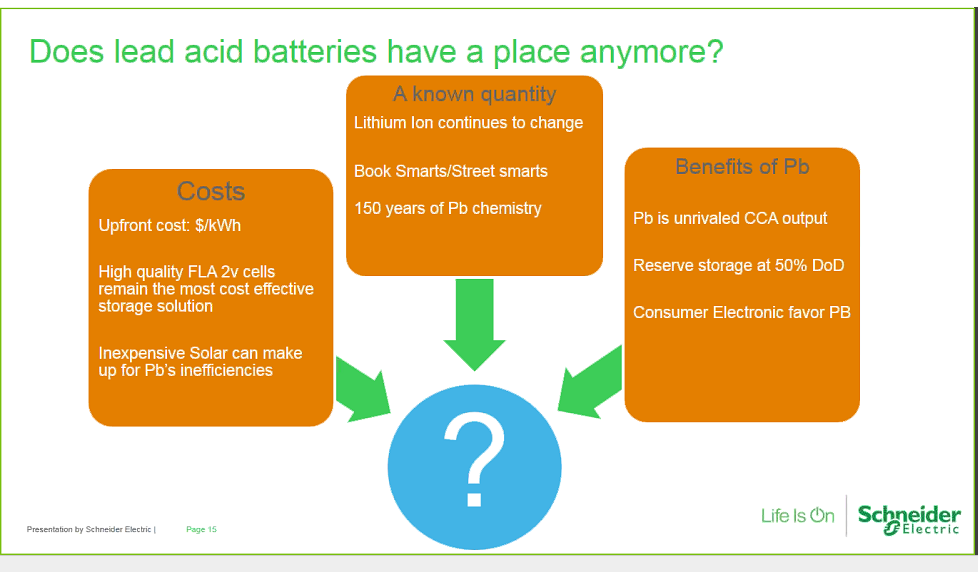
"we go where power lines don't" Sierra Nevada mountain area
htps://offgridsolar1.com/
E-mail offgridsolar@sti.net -
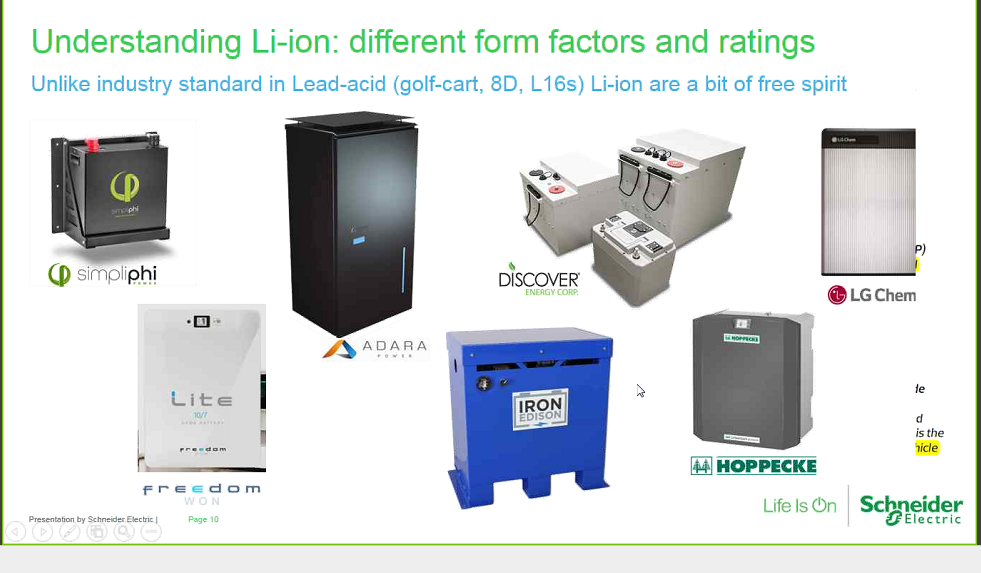 "we go where power lines don't" Sierra Nevada mountain area
"we go where power lines don't" Sierra Nevada mountain area
htps://offgridsolar1.com/
E-mail offgridsolar@sti.net -
One of the things making this slower than Austrailia has been certifications in the US. You really want them!
For testing one wants a nice set of wheels under the battery and acess to the great outdoors!
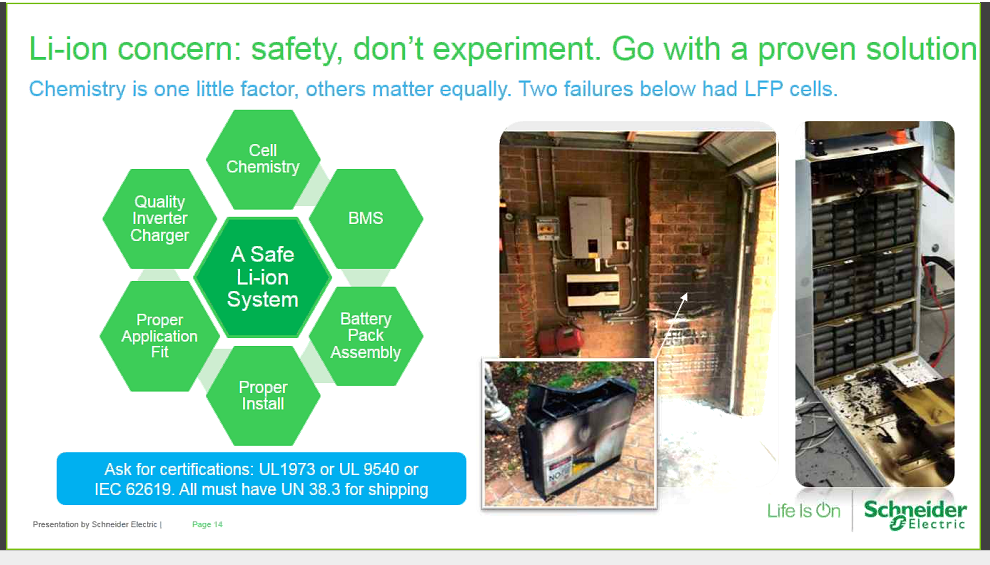
"we go where power lines don't" Sierra Nevada mountain area
htps://offgridsolar1.com/
E-mail offgridsolar@sti.net -
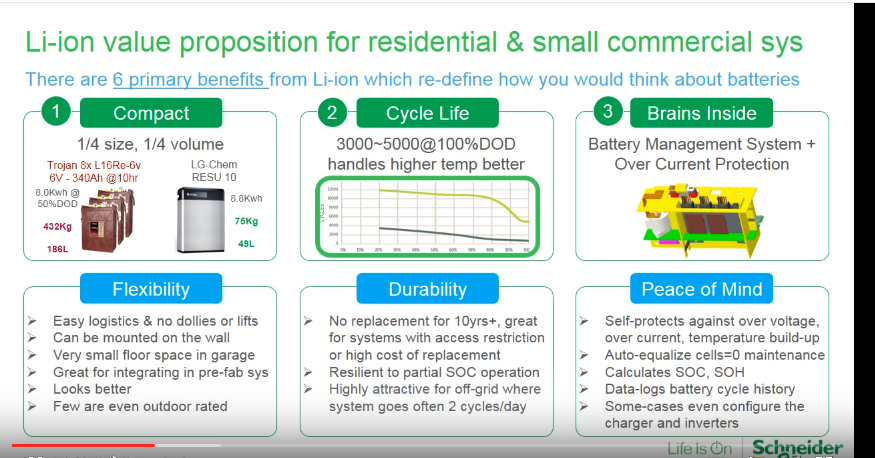
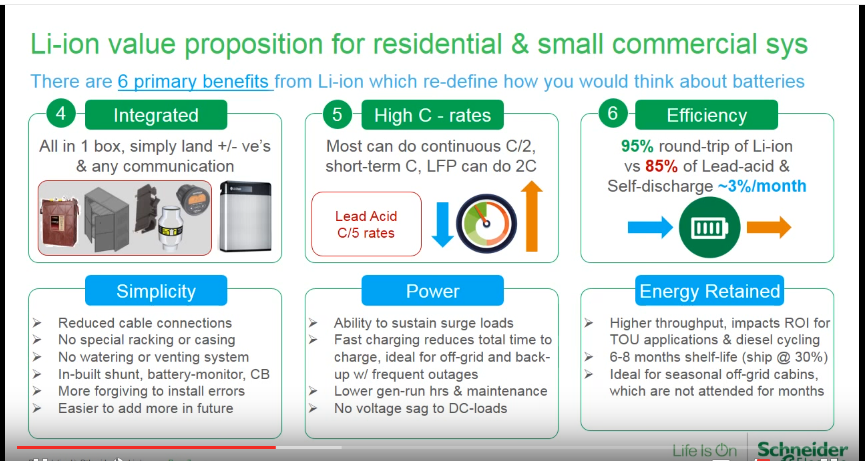 "we go where power lines don't" Sierra Nevada mountain area
"we go where power lines don't" Sierra Nevada mountain area
htps://offgridsolar1.com/
E-mail offgridsolar@sti.net -
Looking more interesting all the time, what's the low temp operating limit for recharging ? Does it have any heaters for below frost ?
Powerfab top of pole PV mount | Listeroid 6/1 w/st5 gen head | XW6048 inverter/chgr | Iota 48V/15A charger | Morningstar 60A MPPT | 48V, 800A NiFe Battery (in series)| 15, Evergreen 205w "12V" PV array on pole | Midnight ePanel | Grundfos 10 SO5-9 with 3 wire Franklin Electric motor (1/2hp 240V 1ph ) on a timer for 3 hr noontime run - Runs off PV ||
|| Midnight Classic 200 | 10, Evergreen 200w in a 160VOC array ||
|| VEC1093 12V Charger | Maha C401 aa/aaa Charger | SureSine | Sunsaver MPPT 15A
solar: http://tinyurl.com/LMR-Solar
gen: http://tinyurl.com/LMR-Lister , -
I will be able to comment on specifics, eventually.
Generic Li-Ions are pretty good at low temps. My costco acurite weather station reccomends them below -4F/-20C over Alkaline."we go where power lines don't" Sierra Nevada mountain area
htps://offgridsolar1.com/
E-mail offgridsolar@sti.net -
A magic wandu!

"we go where power lines don't" Sierra Nevada mountain area
htps://offgridsolar1.com/
E-mail offgridsolar@sti.net -
what is the capacity for a battery like that and can you estimate what they might cost?
Conext XW6848 with PDP, SCP, 80/600 controller, 60/150 controller and Conext battery monitor
21 SW280 panels on Schletter ground mount
48v Rolls 6CS 27P
-
It has not been determined as the tweaking is being done. Stay tuned but my input is around 10KWH of storage."we go where power lines don't" Sierra Nevada mountain area
htps://offgridsolar1.com/
E-mail offgridsolar@sti.net -
Nice size, and since Li-ion isn't hurt by lower SOCs I could get away with two units. Hopefully they will be a reasonable alternative when my LA batteries grow old and weary.
Conext XW6848 with PDP, SCP, 80/600 controller, 60/150 controller and Conext battery monitor
21 SW280 panels on Schletter ground mount
48v Rolls 6CS 27P
-
The world needs a cost effective and reliable, high performance battery solution for off grid applications. You've been excited about this one for awhile now - looking forward to hearing more when you can!
I always have more questions than answers. That's the nature of life. -
I am not sure that cost effective will be in the real world for offgrid apps for some time. Li-Ion is a nice tool to have!
Hard to beat lead acid when the design and user are right. See #2 in this thread.
"we go where power lines don't" Sierra Nevada mountain area
htps://offgridsolar1.com/
E-mail offgridsolar@sti.net -
10-4 Dave!
Cost effective, high capacity, low maintenance storage will be the nut to crack over the next 7 to 10 years. Batteries are the most expensive part of a well designed off grid system and the next generation Li-I/AGM will have to be cost competitive and as reliable/durable/forgiving as the FLAs'.
With a large off grid system like ours, replacement FLAs' cost about $22 k every 5 to 7 years compared to having grid power bills for the same period which would run about $24 k.
Interesting to see if the newer technology can do it reliably cheaper.
Ranch Off Grid System & Custom Home: 2 x pair stacked Schneider XW 5548+ Plus inverters (4), 2 x Schneider MPPT 80-600 Charge Controllers, 2 Xanbus AGS Generator Start and Air Extraction System Controllers, 64 Trojan L16 REB 6v 375 AH Flooded Cel Batteries w/Water Miser Caps, 44 x 185 Sharp Solar Panels, Cummins Onan RS20 KW Propane Water Cooled Genset, ICF Custom House Construction, all appliances, Central A/C, 2 x High Efficiency Variable Speed three ton Central A/C 220v compressors, 2 x Propane furnaces, 2 x Variable Speed Air Handlers, 2 x HD WiFi HVAC Zoned System Controllers -
I would add onto your list Mangas the ability to surge for large motor loads! Merry Christmas to a place I almost made home!"we go where power lines don't" Sierra Nevada mountain area
htps://offgridsolar1.com/
E-mail offgridsolar@sti.net -
Yessir!
With the new Schneider install, I probably have more surge than I need. Also, with the new high efficiency variable speed HVAC compressors, air handlers and appliances power consumption has been dramatically reduced too extending storage capacity.
Woke this morning to snow here on our desert mountains. Beautiful contrast with the red rhyolite bluffs and cactus dusted with snow. Must say ranch is especially beautiful. Big 5x5 buck wandered through with a few does.
Already brushed the panels three times. Temperature coming up.
Sure enjoy following your interesting development projects.
Dave, hope this finds you and everyone enjoying a great Christmas.
Ranch Off Grid System & Custom Home: 2 x pair stacked Schneider XW 5548+ Plus inverters (4), 2 x Schneider MPPT 80-600 Charge Controllers, 2 Xanbus AGS Generator Start and Air Extraction System Controllers, 64 Trojan L16 REB 6v 375 AH Flooded Cel Batteries w/Water Miser Caps, 44 x 185 Sharp Solar Panels, Cummins Onan RS20 KW Propane Water Cooled Genset, ICF Custom House Construction, all appliances, Central A/C, 2 x High Efficiency Variable Speed three ton Central A/C 220v compressors, 2 x Propane furnaces, 2 x Variable Speed Air Handlers, 2 x HD WiFi HVAC Zoned System Controllers -
Thank-you and yes everyone enjoy the holiday! Even the Pagan's who I have a special fondness for this close to the solstice!
We are off to the national park to see the waterfalls. We are at near 20" of rain and that should be nice against the snow.
Back to tech on your post. The XW's are awesome at surge! However, it is the marriage between the battery that enables the listed specifications."we go where power lines don't" Sierra Nevada mountain area
htps://offgridsolar1.com/
E-mail offgridsolar@sti.net -
The idea of bundling an off grid inverter, cc and high capacity maintenance free battery pack is logical.
One OEM manufacturer building a turnkey integrated plug and play scaleable off grid power delivery system which can be stacked to deliver larger scaleable capacities. . .!
Hope I can afford one someday.
Ranch Off Grid System & Custom Home: 2 x pair stacked Schneider XW 5548+ Plus inverters (4), 2 x Schneider MPPT 80-600 Charge Controllers, 2 Xanbus AGS Generator Start and Air Extraction System Controllers, 64 Trojan L16 REB 6v 375 AH Flooded Cel Batteries w/Water Miser Caps, 44 x 185 Sharp Solar Panels, Cummins Onan RS20 KW Propane Water Cooled Genset, ICF Custom House Construction, all appliances, Central A/C, 2 x High Efficiency Variable Speed three ton Central A/C 220v compressors, 2 x Propane furnaces, 2 x Variable Speed Air Handlers, 2 x HD WiFi HVAC Zoned System Controllers -
Mangas I don't know if you have been following this thread on the MidNite board, at about post #330 the new All in ONE is shown... http://kb1uas.com/mnsforum/index.php?topic=602.330.... looks really interesting. Enjoy.
KID #51B 4s 140W to 24V 900Ah C&D AGM
CL#29032 FW 2126/ 2073/ 2133 175A E-Panel WBjr, 3 x 4s 140W to 24V 900Ah C&D AGM
Cotek ST1500W 24V Inverter,OmniCharge 3024,
2 x Cisco WRT54GL i/c DD-WRT Rtr & Bridge,
Eu3/2/1000i Gens, 1680W & E-Panel/WBjr to come, CL #647 asleep
West Chilcotin, BC, Canada -
Thanks westbranch! Have not seen it but will do.
Future ahead!
Ranch Off Grid System & Custom Home: 2 x pair stacked Schneider XW 5548+ Plus inverters (4), 2 x Schneider MPPT 80-600 Charge Controllers, 2 Xanbus AGS Generator Start and Air Extraction System Controllers, 64 Trojan L16 REB 6v 375 AH Flooded Cel Batteries w/Water Miser Caps, 44 x 185 Sharp Solar Panels, Cummins Onan RS20 KW Propane Water Cooled Genset, ICF Custom House Construction, all appliances, Central A/C, 2 x High Efficiency Variable Speed three ton Central A/C 220v compressors, 2 x Propane furnaces, 2 x Variable Speed Air Handlers, 2 x HD WiFi HVAC Zoned System Controllers -
It is like the Outback Skybox another all in one unit (not yet for sale) that will require replacement of all of your existing equipment. I saw the demo at SPI where they called it the B17. Nice that they will finally build an inverter.
I was glad that Schneider did not go that route for now and is waiting to see if there really is a market for this concept yet.
"we go where power lines don't" Sierra Nevada mountain area
htps://offgridsolar1.com/
E-mail offgridsolar@sti.net -
Agree Dave.
For larger applications like ours, I believe "All in One" systems are still many years off. Initially the new bundled smaller systems will probably be aimed at say, 2-4 kw off grid set ups. That's good because in the process these smaller system will increase acceptance for off grid living by reducing installation work, system programming complexity and maintenance which many people find intimidating when they consider making the commitment to build off grid. Larger Market.
As integrated "All In One" storage technology and its control become more mainstream permitting larger integrated applications, I believe Solar OEMs' will cautiously enter this market segment driven by people's ever increasing lifestyle expectations. There will always be a place for small to medium sized out of the box off grid starter systems as well as larger more customized flexible/hybrid ones like ours.
Where I started and where I ended up are good examples. Few people were willing to try what we did in 2005. Since then, most costs have declined except for storage (batteries). Improved appliance power consumption, dramatic increases in our rural grid costs all have helped balance the cost of storage somewhat. Whoever solves this one will be retiring early.
As always, fun to watch the maturation of solar technology in leaps and bounds.
Looks like you're definitely on the leading edge Dave!
Ranch Off Grid System & Custom Home: 2 x pair stacked Schneider XW 5548+ Plus inverters (4), 2 x Schneider MPPT 80-600 Charge Controllers, 2 Xanbus AGS Generator Start and Air Extraction System Controllers, 64 Trojan L16 REB 6v 375 AH Flooded Cel Batteries w/Water Miser Caps, 44 x 185 Sharp Solar Panels, Cummins Onan RS20 KW Propane Water Cooled Genset, ICF Custom House Construction, all appliances, Central A/C, 2 x High Efficiency Variable Speed three ton Central A/C 220v compressors, 2 x Propane furnaces, 2 x Variable Speed Air Handlers, 2 x HD WiFi HVAC Zoned System Controllers -
 "we go where power lines don't" Sierra Nevada mountain area
"we go where power lines don't" Sierra Nevada mountain area
htps://offgridsolar1.com/
E-mail offgridsolar@sti.net -
This diagram shows that the Bridge in an Offgrid mode without the need for internet to monitor the safe and reliable use of the system.
The grid logo can be omitted. The internet cloud also omitted.
"we go where power lines don't" Sierra Nevada mountain area
htps://offgridsolar1.com/
E-mail offgridsolar@sti.net -
Nice it can work without grid and internet.
Powerfab top of pole PV mount | Listeroid 6/1 w/st5 gen head | XW6048 inverter/chgr | Iota 48V/15A charger | Morningstar 60A MPPT | 48V, 800A NiFe Battery (in series)| 15, Evergreen 205w "12V" PV array on pole | Midnight ePanel | Grundfos 10 SO5-9 with 3 wire Franklin Electric motor (1/2hp 240V 1ph ) on a timer for 3 hr noontime run - Runs off PV ||
|| Midnight Classic 200 | 10, Evergreen 200w in a 160VOC array ||
|| VEC1093 12V Charger | Maha C401 aa/aaa Charger | SureSine | Sunsaver MPPT 15A
solar: http://tinyurl.com/LMR-Solar
gen: http://tinyurl.com/LMR-Lister , -
Definitely it can, and it is right now as my ISP is down often! The internet really is just a way to get out easily to the WEB for monitoring anywhere in the world there is internet with a tablet/PC running Conext Insight.
I am just logging the ? from combox and sending data by email to the Engineers.
Pretty blown away by this storage, If I am right it should not be as expensive as I thought at first.
"we go where power lines don't" Sierra Nevada mountain area
htps://offgridsolar1.com/
E-mail offgridsolar@sti.net -
I was told that Tesla uses the LG battery in their Roadster upgrade for increased KW and size. The link below for vid in the article in case my copy did not pick it up.
 https://www.youtube.com/watch?v=q9HbHZXEEDs
https://www.youtube.com/watch?v=q9HbHZXEEDs
"we go where power lines don't" Sierra Nevada mountain area
htps://offgridsolar1.com/
E-mail offgridsolar@sti.net -
There should be some very rough pricing and other info at the end of February along with a Webpage, it has been said.
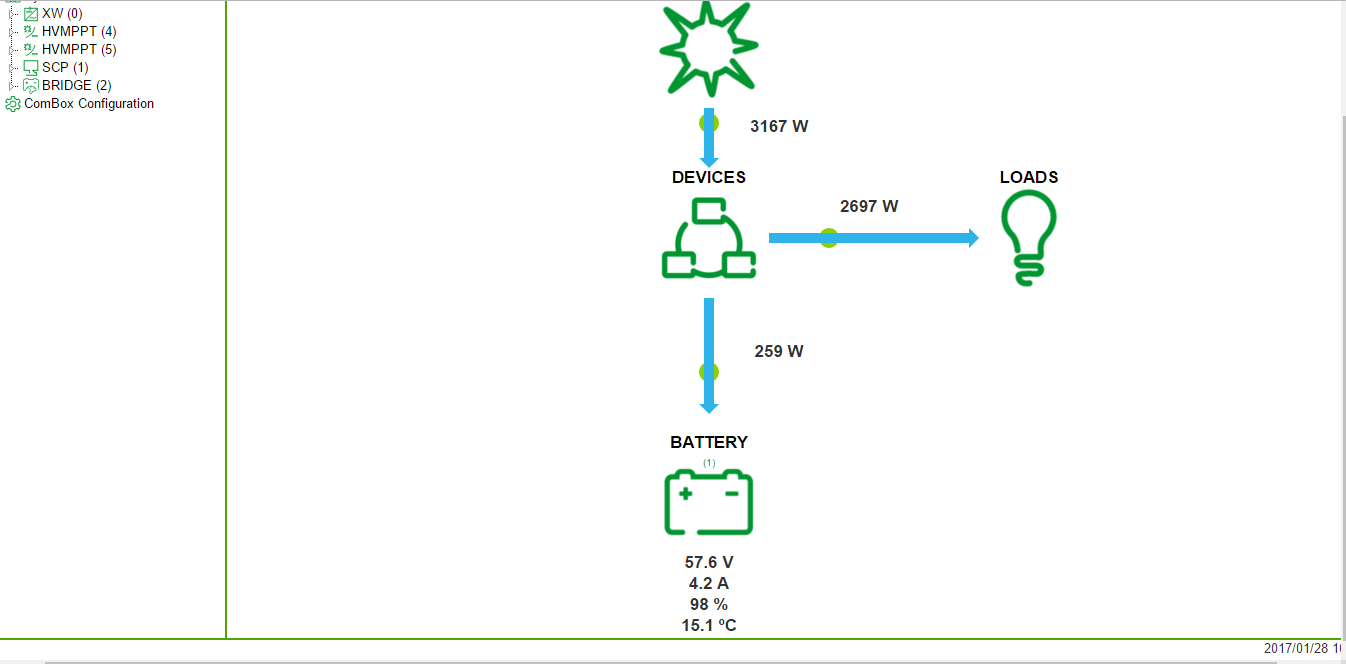
"we go where power lines don't" Sierra Nevada mountain area
htps://offgridsolar1.com/
E-mail offgridsolar@sti.net -
I'd be very interested in the pricing if the unit can be easily wired into my all Conext system.
Conext XW6848 with PDP, SCP, 80/600 controller, 60/150 controller and Conext battery monitor
21 SW280 panels on Schletter ground mount
48v Rolls 6CS 27P
-
Should be updating this soon and the results so far are very good. Below is from an article that describes the challenges and drawbacks of what Tesla has out there. --Dave
SolarEdge and Fronius, for example, offer multiport inverters that work with high-voltage lithium-ion batteries such as Tesla’s Powerwall. In these systems, the PV array and battery both connect to the dc bus of a transformerless inverter, which is very efficient but provides modest surge capacity for motor loads. By contrast, Adara Power and sonnen have designed their energy storage systems around transformer-based inverter platforms (from Schneider Electric and Outback Power, respectively) that use a 48 V nominal battery bank. While these systems are somewhat less efficient, they offer excellent surge ratings for backup loads, which is critical to customers who need to run essential equipment—say, a well pump—during a power outage. To add solar to a sonnenBatterie, integrators must ac-couple an interactive inverter with the battery-based inverter via the ac bus in the backup-loads subpanel. The Adara Power system accommodates both ac- and dc-coupled configurations. The former is most cost-effective in retrofit applications where an existing interactive inverter can process PV power. The latter uses a 600 V Schneider charge controller to integrate the PV power source. SMA, meanwhile, is releasing a new Sunny Boy Storage inverter—designed especially with the retrofit market in mind—that will allow integrators to ac-couple solar with a high-voltage battery.
As the market matures, we will likely see increased demand for something parallel to an Energy Star rating method targeting home energy storage systems. This may be a long time coming in practice, however, based on the slow progress in the multiyear international efforts to develop comparative tests and ratings for PV modules. In the meanwhile, system integrators and developers may want to take vendors’ round-trip efficiency claims with a grain of salt. Self-reported efficiency values are suspect, if only because they likely reflect best-case scenarios. In the real world, inverter loading and battery cycling is highly variable, which could reduce round-trip system efficiency in the field.
"we go where power lines don't" Sierra Nevada mountain area
htps://offgridsolar1.com/
E-mail offgridsolar@sti.net -
Schneider's AC-Coupling of Inverters document 976-0240-01-01 Rev D says an AC-coupled Conext XW+ cannot be used with a lithium-ion pack. It says failure to follow this instruction can result in battery damage. Do you know if the new Conext Bridge will provide necessary protection to modify this direction (allow AC-couple of a SolarEdge HD-Wave in off-grid application)?
Categories
- All Categories
- 227 Forum & Website
- 135 Solar Forum News and Announcements
- 1.3K Solar News, Reviews, & Product Announcements
- 198 Solar Information links & sources, event announcements
- 895 Solar Product Reviews & Opinions
- 255 Solar Skeptics, Hype, & Scams Corner
- 22.4K Solar Electric Power, Wind Power & Balance of System
- 3.5K General Solar Power Topics
- 6.7K Solar Beginners Corner
- 1K PV Installers Forum - NEC, Wiring, Installation
- 2.1K Advanced Solar Electric Technical Forum
- 5.5K Off Grid Solar & Battery Systems
- 428 Caravan, Recreational Vehicle, and Marine Power Systems
- 1.1K Grid Tie and Grid Interactive Systems
- 652 Solar Water Pumping
- 815 Wind Power Generation
- 624 Energy Use & Conservation
- 617 Discussion Forums/Café
- 310 In the Weeds--Member's Choice
- 75 Construction
- 124 New Battery Technologies
- 108 Old Battery Tech Discussions
- 3.8K Solar News - Automatic Feed
- 3.8K Solar Energy News RSS Feed